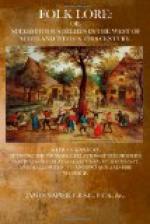BELTANE.
Beltane or Beilteine means Baals fire, Baal (Lord) was the name under which the Phoenicians recognized their primary male god, the Sun: fire was his earthly symbol and the medium through which sacrifices to him were offered. Hence sun and fire-worship were identical. I am of opinion that originally the Beltane festival was held at the Spring equinox but that its original connection with the equinox, in process of time was forgotten, and it became a festival inaugurative of summer. There is some difference of opinion as to the particular day on which the Beltane festival was held in this country. Dr. Jamieson, Dr. R. Chambers, and others who have studied this subject say that the 1st May (old style) was Beltane day. Professor Veitch; in his History and Poetry of the Scottish Border, (p. 118,) says, speaking of the Druids:—“They worshipped the sun god, the representative of the bright side of nature—Baal, the fire-giver—and to him on the hill tops they lit the fire on the end of May, the Beltane.” And again, in his remarks on Peblis to the Play, (p. 315,) he says:—“The play was not the name for a stage play, but indicated the sports and festivals which took place at Peebles annually at Beltane, the second of May, not the first of May, as is usually supposed. These had in all probability come in place of the ancient British practice of lighting fires on the hill tops in honour of Baal, the sun god, hence the name Baaltein, Beltane, i.e. Baal’s fire. The Christian Church had so far modified the ceremonial as to substitute for the original idolatrous practice that of a day of rustic amusements. A fair or market at the same period which lasted for eight days had also been instituted by Royal charter. But even the practice of lighting fires on the hill tops was late in dying out, with the usual tenacity of custom it survived for long all memory of its original meaning.”
The Professor writes very positively as to Beltane day being the second day of May, not the first day as is supposed. The Royal Charter granted to the Burgh of Peebles for holding a fair or market on Beltane day, is given in the Burgh Records of Peebles, p. 85:—“As also of holding, using, enjoying, and exercising within the foresaid Burgh weekly market days according to the use and custom of the said Burgh, together with three fairs, thrice in the year, the first thereof beginning yearly upon the third day of May, called Beltane day, the same to be held and continued for the space of forty-eight hours thereafter.” The date of the Charter is 1621, but it is evident that the third of May had been previously kept as Beltane day. The Professor is also mistaken in stating that the Beltane fair of Peebles was to be kept for eight days. The third fair, held in August, continued eight days, but the fairs in May and June were kept for two days according to the Charter. That there were two days known as Beltane at the beginning of last century is evident from a book of Scotch proverbs published in 1721 by James Kelly, A.M., in which occurs the following,—




